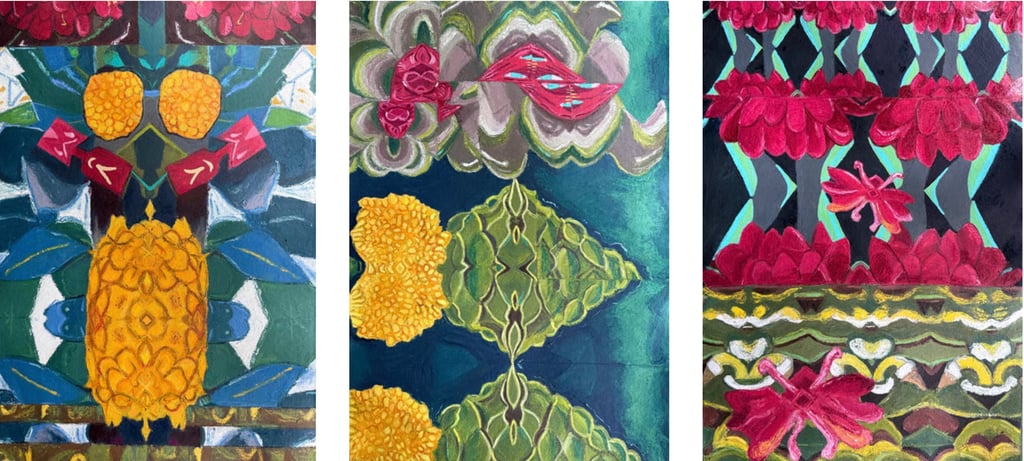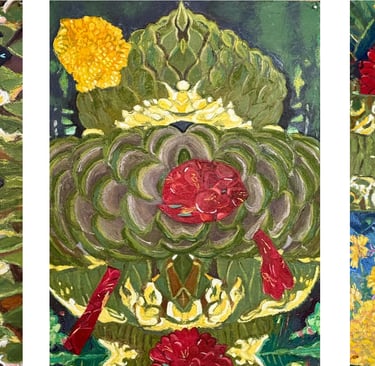This triptych's collective title, If Not for Love of Thee, is also the title of the panel on the right. I feel that it leans toward the emotional—rooted in the symbolic language of blossoms and offerings and therefore, the outward expression of devotional longing. Cocooning in Place, the one the middle feels quieter and more interior, like a suspended moment of a chrysalis before change. Indra, King of the Devas, on the left, reaches upward, drawing from mythology and ceremony to invoke a sense of power and divine order. Together, they reflect different aspects of the same inquiry: how can form, color, and pattern be used to transmit energy, attention, and intention?
At the core of my practice is a commitment to mystical abstraction—an approach that begins with recognizable forms (flowers, plants, dirt, wood, leaves) and sometimes through a decorative sensibility, distilling them into something more ambiguous and symbolic. This is not abstraction for its own sake, but a method of opening the image into multiple realms—bodily, botanical, spiritual, and psychological. I often work through collage sketches first, then translate these into oil paintings, where the rhythms of repetition and mirroring take on a more meditative or trance-like quality. Most of my work goes through multiple iterations in order to find its most resonant conclusion and since each iteration builds on the one before, painting becomes a ritualistic practice for me. - R. Kintisch, Summer 2025




Notes on the Deva Encounters Triptych
On the subject of iteration—this is how it plays out in my practice. These paintings started as collages made from fragmented photographs. I’ll often create several collages that share similar shapes, colors, or rhythms, and then group them in twos or threes based on intuition rather than plan. The meaning doesn’t come first; it surfaces later, almost unconsciously. I like to get to the point where I’m out of my own way. Once the collaged sketches are painted, I’ll sometimes start over—collaging again, but this time from the paintings instead of the photos. That second round usually pushes the abstraction further, which is where I want to go. Sometimes I’ll keep going, repeating this process several times. Each new version distorts, refines, and deepens the previous one—like a visual echo growing more mysterious each time it returns.
This triptych is called Deva Encounters of the Third, Second, and First Kinds.
The order is reversed, so that the “Third Kind” is on the left and the “First Kind” on the right. I like that inversion; it keeps things from reading too linearly. To me, the three panels together form a kind of descent—or maybe an unfolding—of devotional experience. What begins as something ethereal in First Kind condenses toward structure in Second Kind and then blooms into material intimacy in Third Kind. But because the titles move backward, there’s this mirrored logic at work: a cycle instead of a straight line, more like mantra or breath than narrative.
The word “Deva” comes from Sanskrit—it means “shining being.”
In these works, that light or divinity doesn’t appear as a figure, but through vegetal forms: garlands, blossoms, and coded botanical patterns. The divine here isn’t something to look at—it’s something that radiates through everything. The paintings borrow the language of flowers and growth: blooming, mutating, decaying, pollinating. They’re alive, not static icons.
Ultimately, Deva Encounters is a devotional work, but not in a doctrinal sense. It’s a visual theology built through paint, intuition, and repetition—one that’s more about experience than belief. Rather than depicting the divine, it lets those patterns emerge on their own, through rhythm, color, and form.
— R. Kintisch, Summer 2025